After the first two games after the restart of the Austrian Bundesliga, we saw that LASK Linz and Rapid Vienna are already on a quite decent level, but not there where they want to be. Rapid have huge problems with injuries while LASK aren’t yet able to show the amazing performances they did in the 22 matches ahead of the break.
Ahead of this direct clash between these two teams, Rapid Vienna sat with 23 points in the third position behind Wolfsberger AC and RB Salzburg. The team of Valérien Ismaël were one point behind them in the fourth position.
In this tactical analysis, we will talk about the tactics of both teams in this game and the reasons for this 1-0 victory of Rapid against LASK Linz.
Lineups
Linz went with their typical 3-4-3 formation as they always do with two little adjustments compared to their draw against Wolfsberger AC. Alexander Schlager was in goal and the back three in front of him was made out of Philipp Wiesinger, Gernot Trauner and Petar Filipovic who got into the team for Christian Ramsebner. Peter Michorl and James Holland occupied the centre while Reinhold Ranftl and Andrés Andrade. Usually, René Renner is the left-wing-back, but this time Ismaël gave him a break and Andrade got the chance to play in his third game in this season for LASK in the Bundesliga (usually plays for their second team). Upfront we had the usual front three with Husein Balić, Dominik Frieser and Marko Raguž.
On the other side, Dietmar Kühbauer also went with a 3-4-3 formation as he mainly did in this season in the games against RB Salzburg and LASK Linz. Tobias Knoflach replaced the injured Richard Strebinger in goal. Leo Greiml, Dejan Ljubicic (who is usually defensive midfielder) and Maximilian Hofmann were the three defenders. Since three of their best central defenders are out due to injuries, they had to play with Ljubicic and Greiml who is just 18 years old. Dejan Petrovič and Srdjan Grahovac played in the central midfield while Maximilian Ullmann and Stephan Auer were the wing-backs. In attack, Kühbauer put Ercan Kara into the starting eleven while their top striker Taxiarchis Fountas was on the bench. Kelvin Arase and Stefan Schwab supported him upfront.
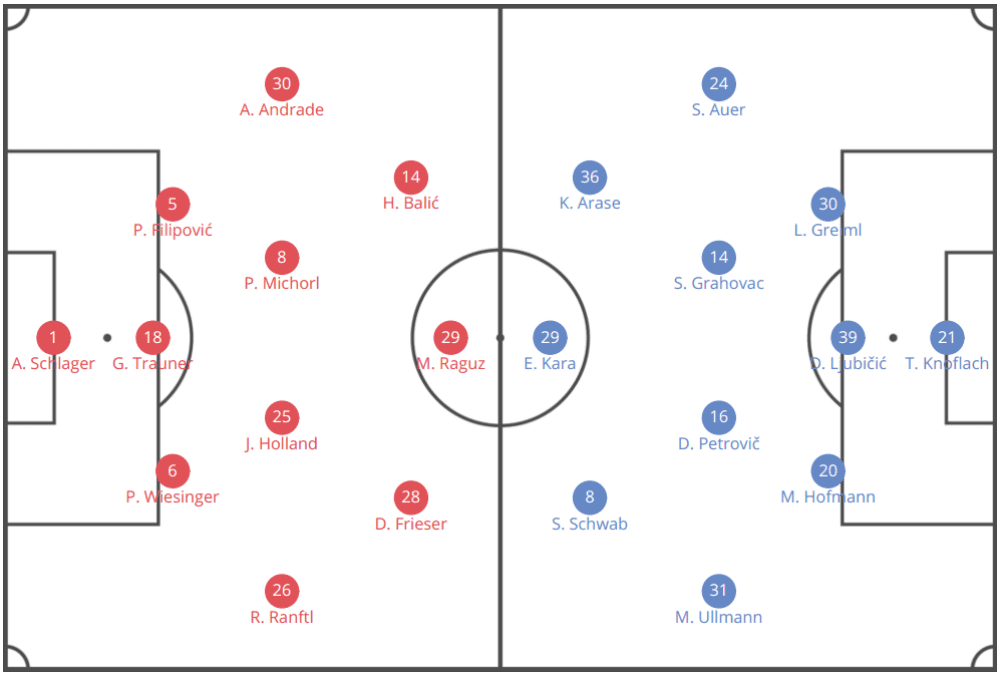
LASK’s flexibility
Before we look at the tactics of both teams in this tactical analysis, I have to note that both teams had similar plans in this game. LASK Linz and Rapid Vienna wanted to give the opposition no chance on the ball, pressed quite high up the pitch and had as a main offensive principle long balls to then win the second ball. This can also be seen when we look at the following stats: 6% of LASK’s 143 possession phases reached the opposition’s penalty area while 1% of Rapid Vienna’s 135 attacks reached the penalty box of the opponent. 14% of the passes of Linz were long balls while Rapid Vienna has a value of 26% for this category – both quite high.
However, still, there were some interesting tactical concepts and even though overall both teams neutralised each other quite well, there were some moments in which you saw that both sides slightly adjusted their offensive tactics to have more chances when it comes to the progression of the ball.
The game was extremely intense and neither team were really able to have longer periods of possession due to two aspects: the high press on both sides (plus the counter-press of LASK Linz) and the man-orientation of both teams. Since the two teams played with a 3-4-3 formation, we had one-on-one situations all over the pitch.
No matter which team were in possession of the ball, the other team marked every opponent in a man-orientated fashion and pressed high up the pitch. Especially during the first half, the high pressing of both clubs was really effective while in the second half Rapid more frequently dropped a few yards deeper and put pressure on the back three of LASK at about the half-way line.
When Ismaël’s team build-up their attacks from the back, Rapid’s front three used curved runs to force them to one side where they then put pressure on the outer man of the back three whilst cutting off all nearby passing options. The wing-back marked the opposition wing-back while the central midfielders tightly man-marked Holland and Michorl. In general, we saw as already noted all over the place that the players got man-marked. This can be seen in the following shot. Also, notice the curved run of Schwab to block the pass into the centre.
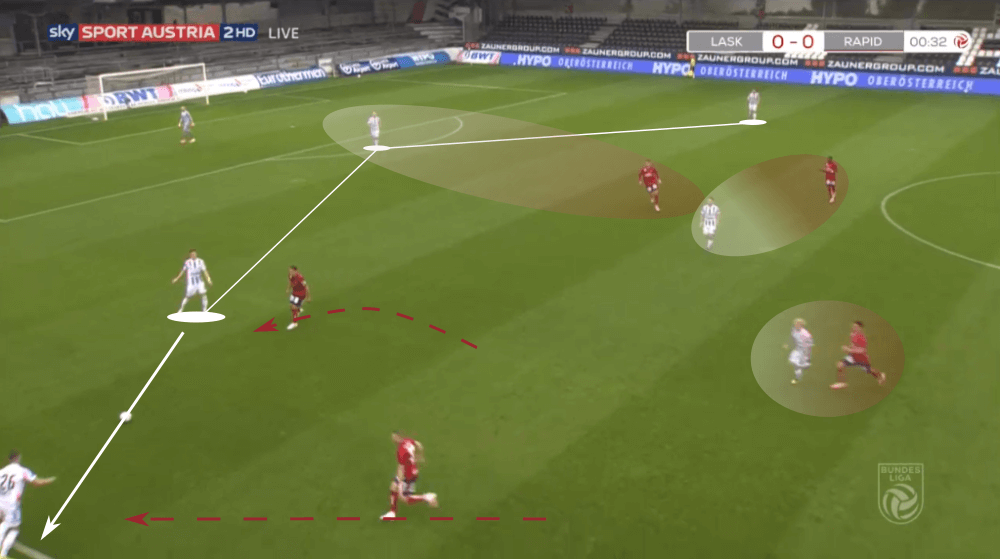
One central reason for this curved run by Schwab is that one of LASKs’ main tactics is to immediately play the ball into the centre towards the three forwards (wingers tuck in to be near the central striker). We can watch frequently how they play high or low passes towards the central man upfront and try to then win the second ball or ideally the forward can lay it off for one of the wingers or central midfielders.
Raguž is the perfect man for these tactics since he has the technical abilities to lay off the ball, but additionally the necessary height to win aerial duels. In the shot below we can see a typical example of how they try to find the young Austrian striker with a diagonal ball.
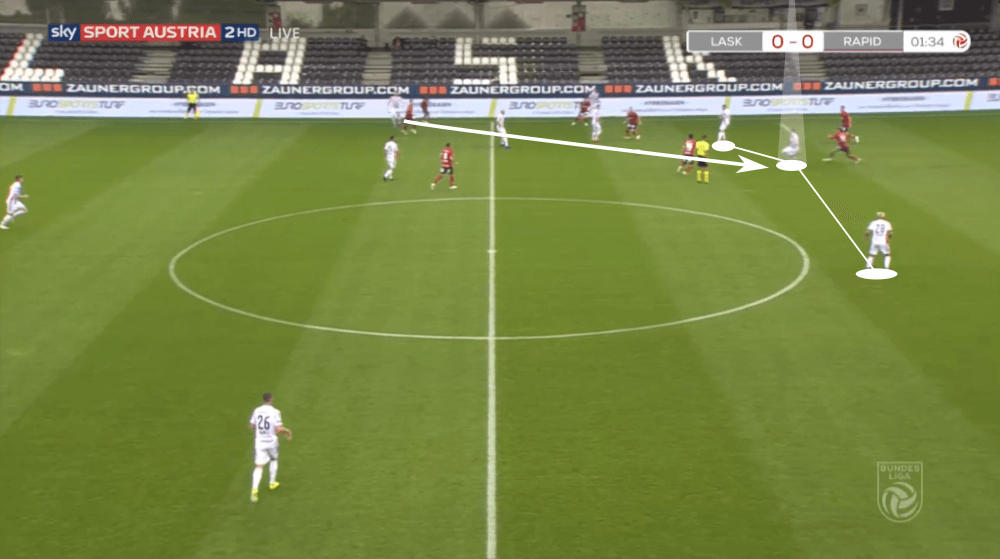
Since Rapid Vienna had quite similar tactics in possession as we will see in the next part of this tactical analysis, two central duels in this game were clearly the ones between the central forward and the central man of the back three on each side. So, we saw throughout the game Kara vs Trauner and Raguž vs Ljubicic. While Trauner and Kara are both physically extremely strong, Raguž has clear advantages compared to Ljubicic when we look at the power and physique.
However, the Austrian midfielder who had to play as a central defender due to the several injuries did quite well and often used his intelligent positioning to win duels against his opponent as we can see below in a moment of transition.
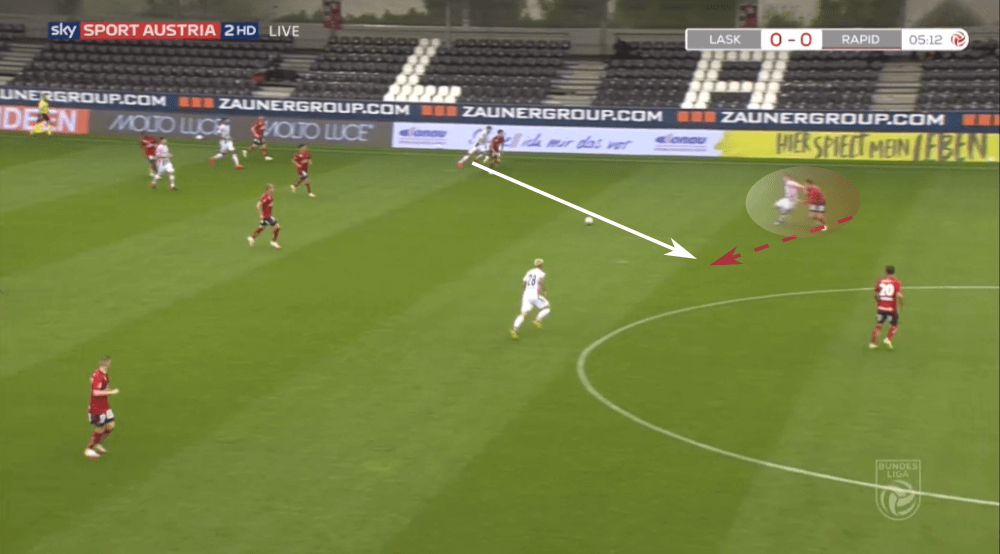
Besides the long balls towards Raguž, they had also two other ways to enter the final third where through passes and crosses were the main tactics which didn’t quite work. Due to that, we will focus on the other two patterns to get forward for now.
As I already noted above in this tactical analysis, the two wingers mainly positioned themselves centrally in the half-spaces to be near their teammate Raguž and give him an option when he can lay off a forward pass.
Additionally, due to this central positioning, they aren’t in the same vertical line as the wing-backs (who permanently stay near the touchline) and because of that, a vertical pass towards them is possible. We can see in the image below a situation during the press by Rapid in which Balić dropped deeper to provide another passing option since mainly in these moments they went for the long ball.
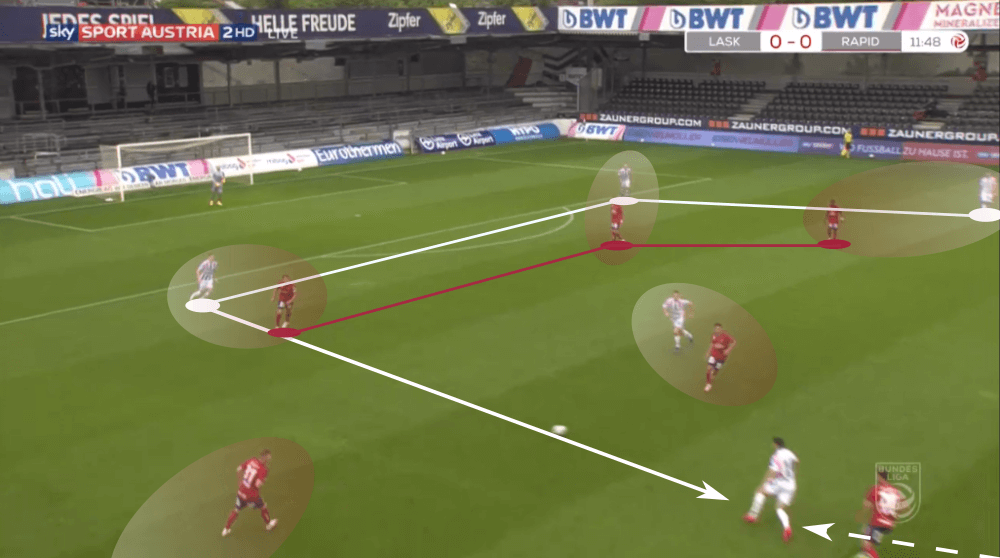
The second pattern mainly worked in the periods when Rapid Vienna decided to drop back deeper. They did so to save some energy and additionally hoped that Linz’s defenders would also push up further which would give them more room for counter-attacks (LASK’s great counter-pressing rarely gave Rapid Vienna the chance to even start a counter-attack).
Whenever they decided to defend deeper, Rapid wasn’t that man-orientated anymore and concentrated more on staying in their formation and focused more on occupying the dangerous space. However, the left central midfielder Michorl often then found free spaces in the defensive structure of Kühbauer’s side and LASK could exploit that by diagonal passes from Wiesinger to Michorl as we can see in the example below.
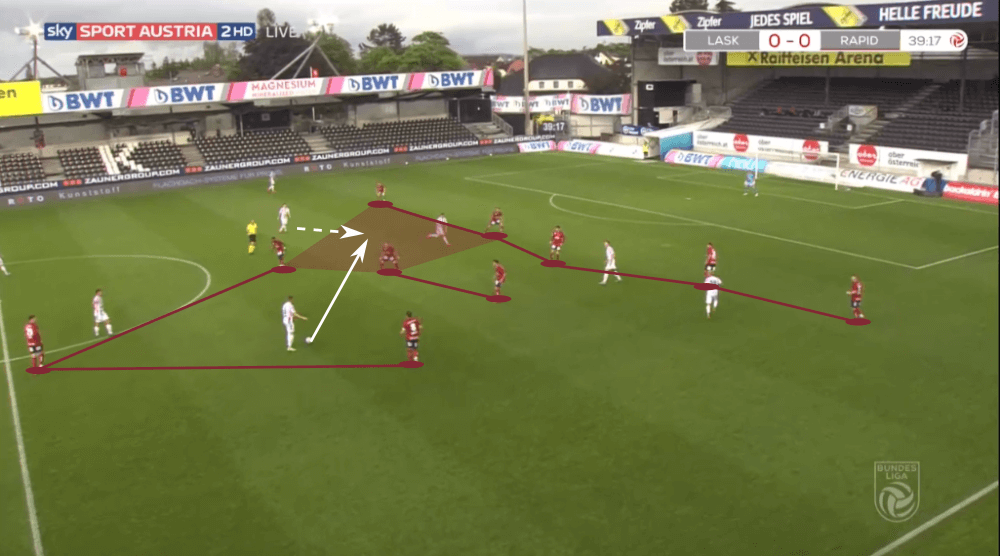
Rapid’s harmless offence
During the first half of the season, RB Salzburg showed great performances against Liverpool and Serie A giants Napoli in the UEFA Champions League especially with their high and intense pressing which made them famous. Meanwhile, LASK Linz did the same in the UEFA Europa League where they bet big names like PSV and Sporting Lisbon.
While their offensive game seems to be less dangerous compared to before the break due to the coronavirus, their pressing is still quite effective as we saw in this game. Rapid were rarely able to have a structured build-up due to the man-orientated press by Linz.
Kühbauer expected exactly that and replaced the smaller and quick Fountas by adding the tall and powerful Kara who played besides Schwab their main target for long balls as we can see below.
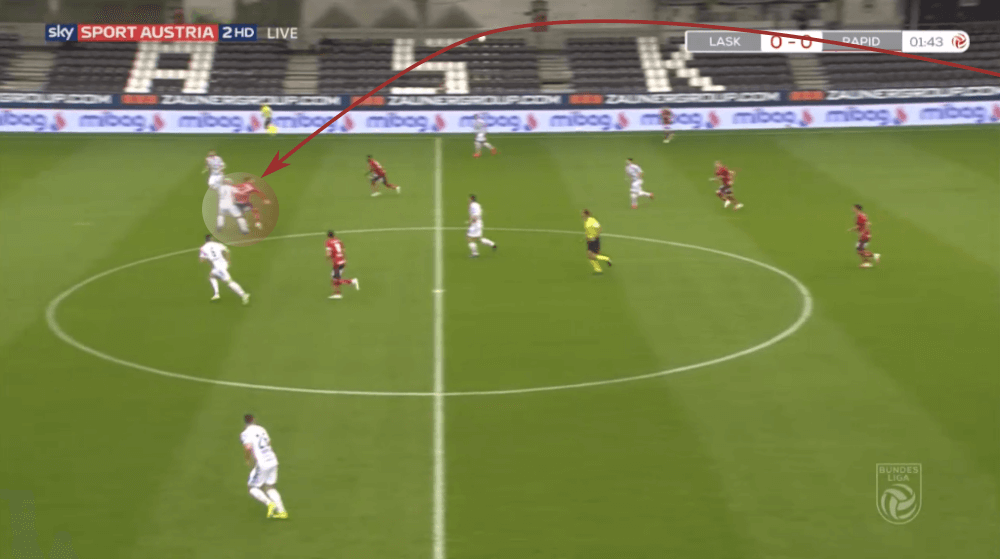
Their basic idea was to find Kara or Schwab upfront who should win the aerial duel to lay the ball off for each other or a central midfielder who should then find the pacey Arase with a through ball. However, Kara had a hard game against one of the best central defenders of the Austrian Bundesliga, Trauner.
As he rarely was able to keep the ball for his side, they switched their approach after about 35 minutes and tried to not play long balls towards him which forced him into aerial duels with Trauner, and instead, played high through passes into the space behind Wiesinger. This worked much better as then Kara could use his strength to shield the ball and then either play a through pass or lay it off.
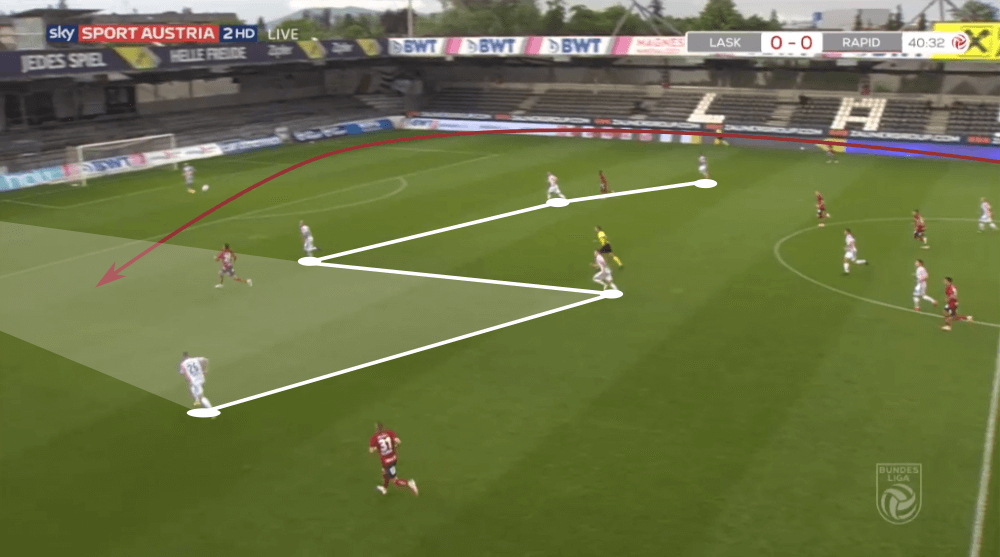
Another player who was in this game and was extremely vital for the game of LASK Linz was Holland. While Michorl had several great moments during the attacks, the Australian midfielder was very important for the press of LASK even though it didn’t stand out at first glance. He and Michorl man-marked their direct opponents during the press to not give the defenders of Rapid the option for a short pass. Furthermore, Holland constantly scanned the space behind him to see if one of the three forwards of Rapid dropped in the space behind him to offer a vertical passing option. As soon as this happened, he made a few steps to the according side to intercept the pass. He was able to do so several times throughout this game and stopped quite a lot of Raid Vienna attacks.
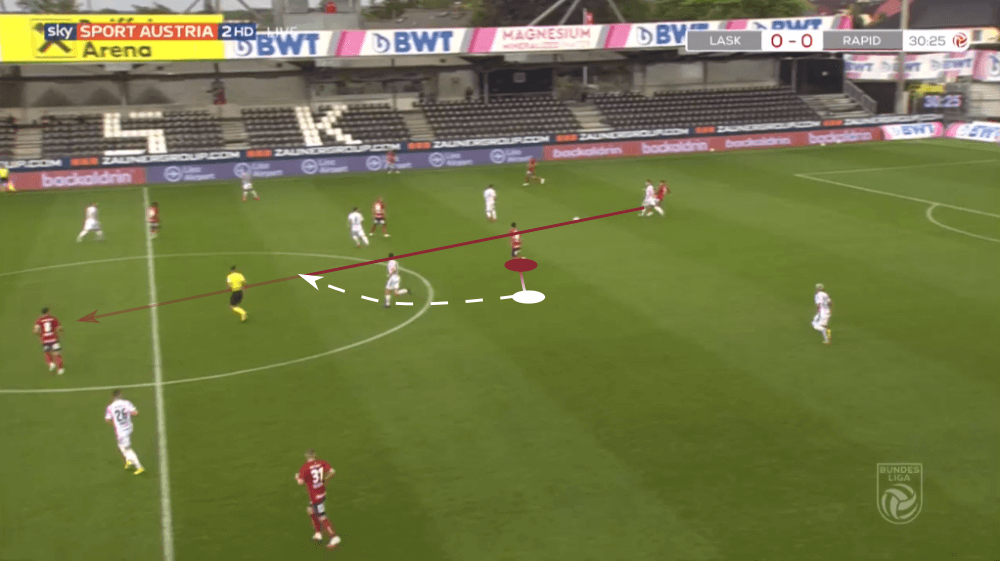
One additional aspect which made Rapid so harmless in this game was their miserable positioning ahead of second balls. Both teams used many long passes towards the central strikers throughout this match and therefore we also saw a lot of fights for the second ball. However, in the majority of situations, LASK Linz had a better structure what meant in most moments they would win the second ball as we can see below. In this situation, Rapid had enough players around the ball, but there were several players occupying the same space while the place where the header of Schwab went to was only occupied by players of LASK.
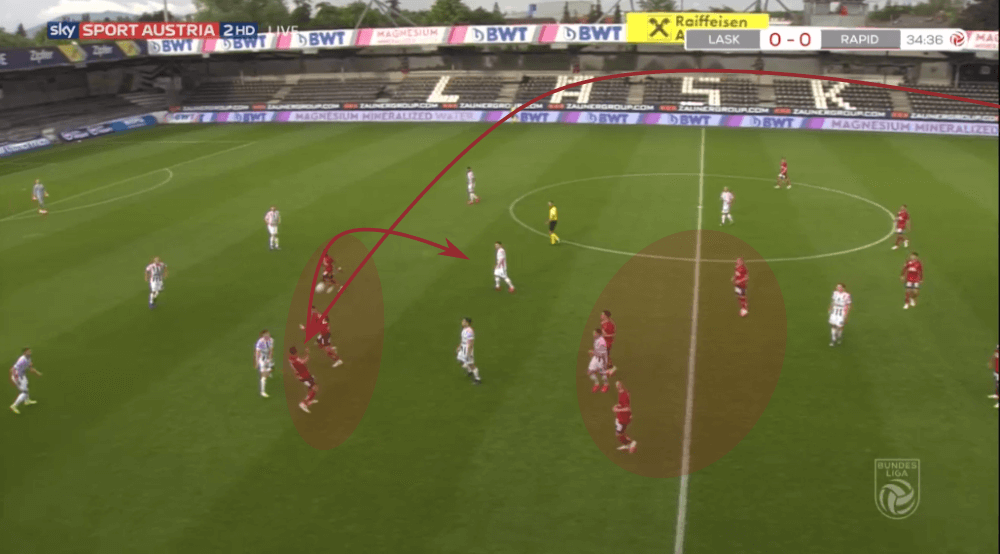
Fountas’ impact
In the 62nd minute, Kühbauer brought on Fountas for Kara and Thorsten Schick for Auer. While Schick added a bit more offensive power to the game of Rapid Vienna, Fountas is a completely different type of player compared to Kara. It was likely that the plan of Kühbauer to sub on Fountas was when the defence of LASK was already a bit tired which makes his mobile style of play even more dangerous.
He instantly helped his teammates by occasionally dropping deeper to give them an easier passing option since he would have no chance in an aerial duel against Trauner. We can see this in an example below.
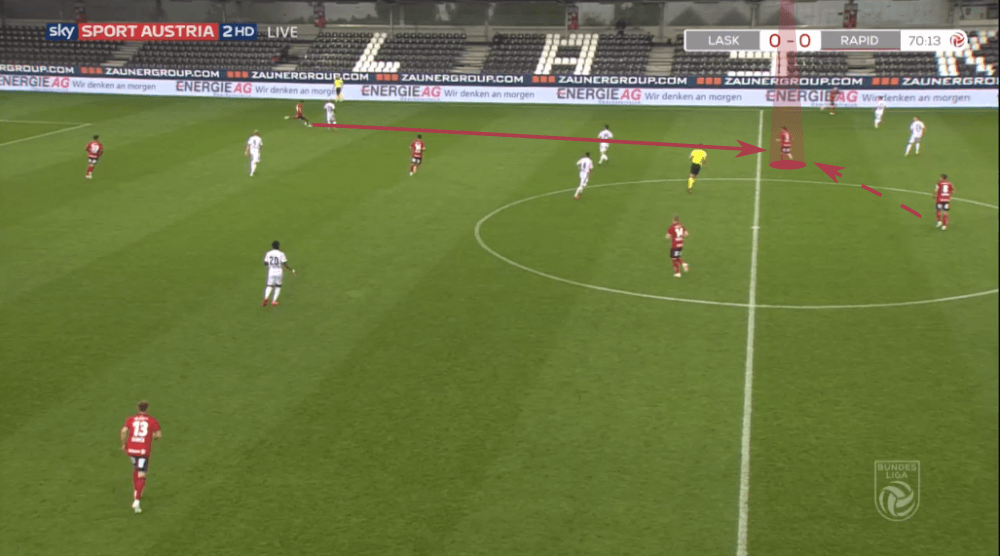
Furthermore, the Greek striker was the one who scored the only goal of this game in the 87th minute. You have to clearly say that this was a big mistake by Wiesinger and doesn’t have that much to do with the style of play of Fountas, but he takes the shot perfectly with his first touch to beat Schlager which shows his huge quality.
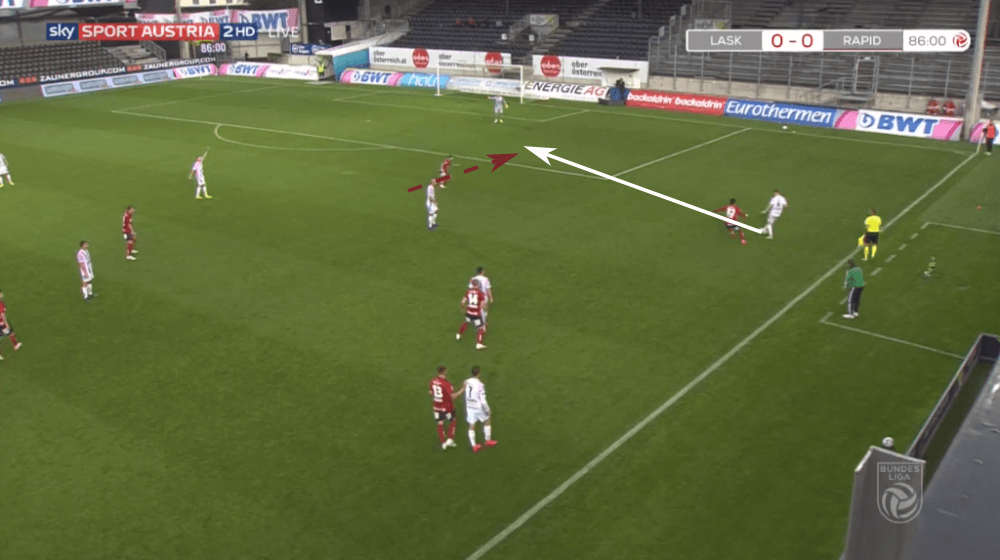
However, in the final moments of the game, we saw the reason why Kühbauer subbed him on as Fountas received a long ball during a counter-attack, controlled it perfectly with his first touch, used his speed to get away from the defenders and then took a clever shot which hit the crossbar. In this situation, we saw perfectly why Kara started the game and the Greek striker replaced him later in the game.
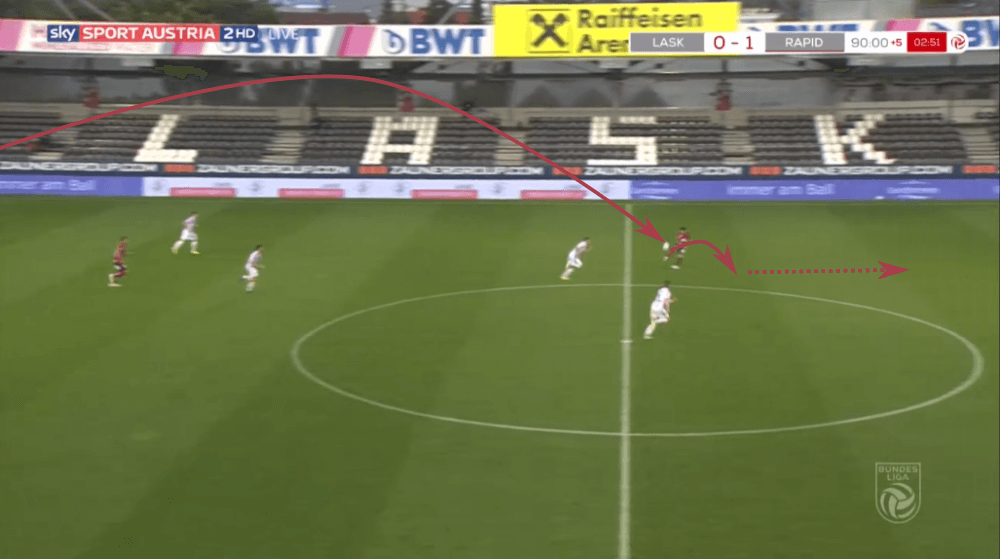
Conclusion
All in all, both teams were rarely able to create goalscoring chances in this game as the xG-values tell us: 0.65 for LASK and 0.68 for Rapid Vienna. Due to that, it is absolutely no surprise that the only goal of the game was the result of a horrible mistake by Wiesinger.
Both teams neutralised each other since they had similar tactics: intense, high and man-orientated press and long balls to win the second ball. LASK was a bit more variable in possession, but rarely created anything dangerous. After this win for Rapid Vienna, LASK has only got one point from the opening three games after the restart and are now in the fourth position. Furthermore, their upcoming game is against Salzburg while Rapid will face Wolfsberger AC.





Comments